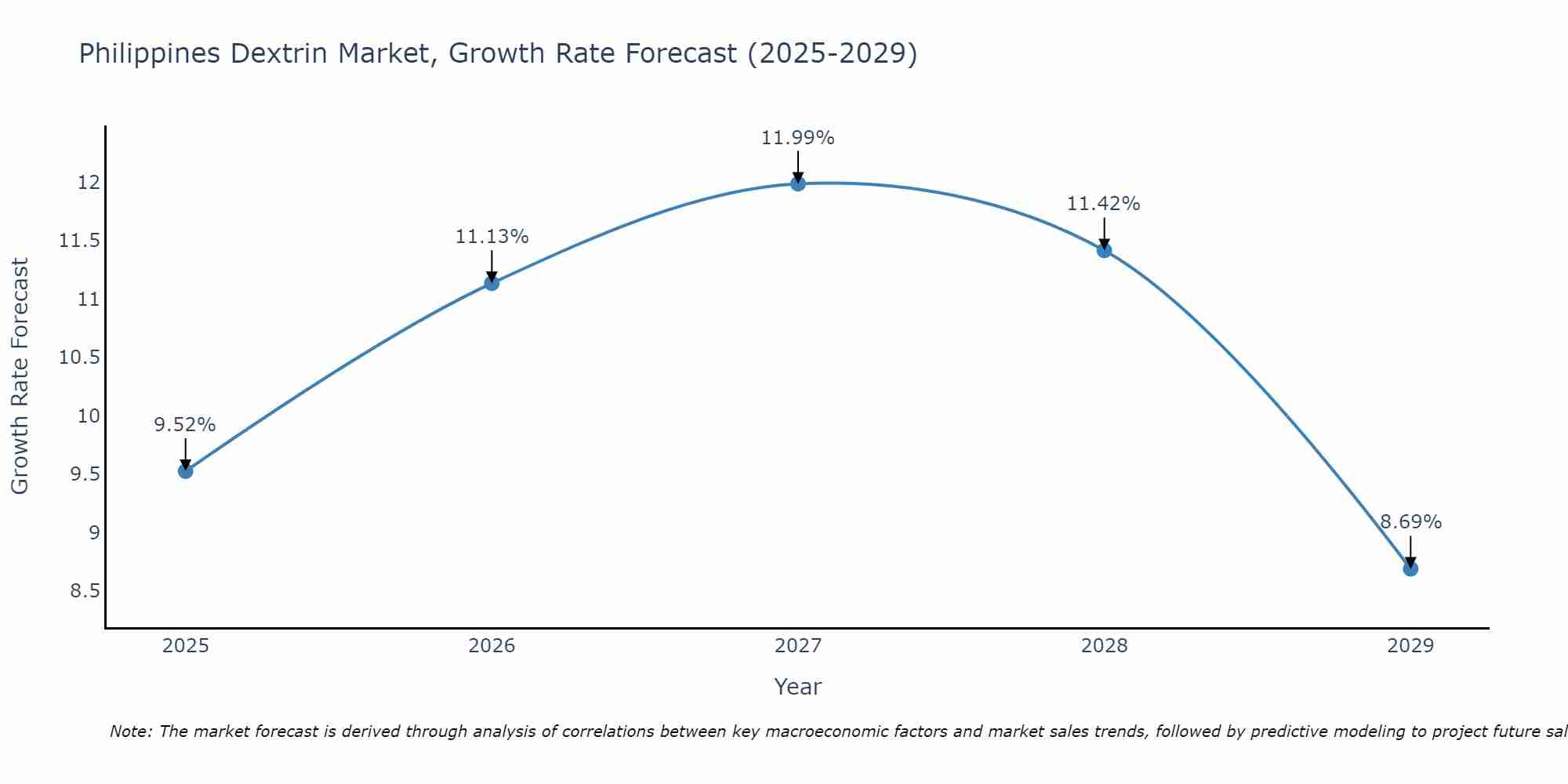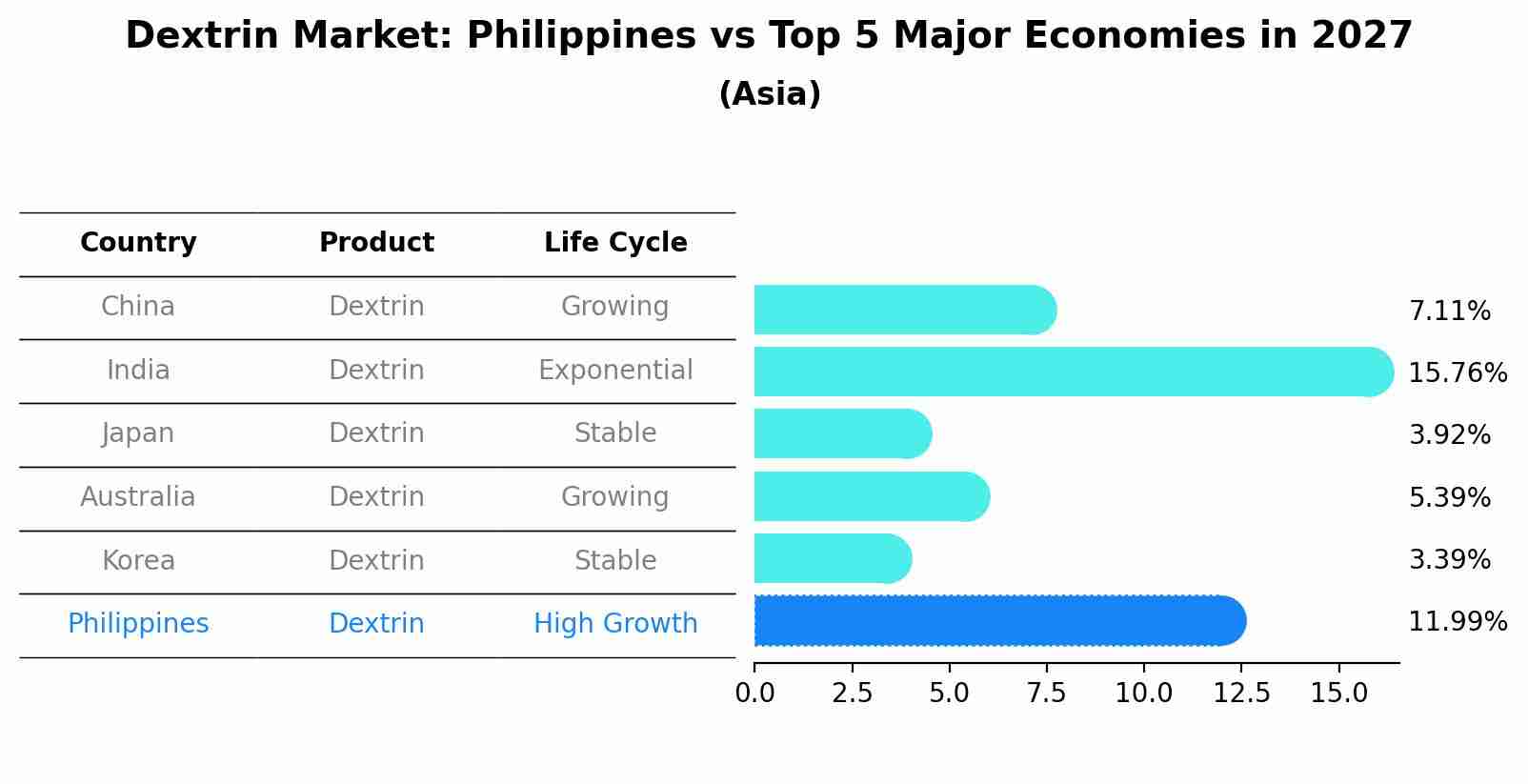Philippines Dextrin Market (2025-2031) Outlook | Analysis, Revenue, Share, Companies, Forecast, Size, Industry, Value, Growth & Trends
| Product Code: ETC094008 | Publication Date: Jun 2021 | Updated Date: Apr 2025 | Product Type: Report | |
| Publisher: 6Wresearch | No. of Pages: 70 | No. of Figures: 35 | No. of Tables: 5 | |
Philippines Dextrin Market Size Growth Rate
The Philippines Dextrin Market is projected to witness mixed growth rate patterns during 2025 to 2029. The growth rate begins at 9.52% in 2025, climbs to a high of 11.99% in 2027, and moderates to 8.69% by 2029.

Dextrin Market: Philippines vs Top 5 Major Economies in 2027 (Asia)
Philippines's Dextrin market is anticipated to experience a high growth rate of 11.99% by 2027, reflecting trends observed in the largest economy China, followed by India, Japan, Australia and South Korea.

Philippines Dextrin Market Synopsis
The Philippines Dextrin market is expected to reach a value of US$ 59.10 million, exhibiting a CAGR of 4.5%. The demand for dextrin is driven by the increasing popularity and usage of processed food products in the country. It is used as an adhesive in paperboard packaging, as well as a stabilizer and texture modifier in various food products including desserts, canned foods and soups. Additionally, growing demand from industries such as pharmaceuticals, cosmetics and paint are also driving the growth of the market
Drivers of the market
The Philippines Dextrin market is primarily driven by a combination of factors that reflect the dynamic nature of the country`s industrial landscape and consumer preferences. One of the key drivers is the growing demand for dextrin in various industrial applications, ranging from adhesives and coatings to textiles and food products. Dextrin`s versatile properties as a binder, thickener, and stabilizer make it a valuable ingredient in industrial processes, contributing to enhanced product performance and quality.
Challenges of the market
The Philippines Dextrin market faces several challenges that impact its growth and sustainability. One significant challenge is the fluctuation in raw material prices. Dextrin production relies on starch, typically sourced from crops like corn, tapioca, or potatoes. Variability in crop yields, weather conditions, and market demand can lead to fluctuations in starch prices, affecting the overall production cost of dextrin. These price fluctuations can make it challenging for manufacturers to maintain consistent pricing for their dextrin products, impacting their competitiveness in the market. Another challenge is the increasing competition from alternative food additives and thickeners. As consumer preferences shift towards natural and clean label ingredients, manufacturers are exploring alternatives to synthetic additives like dextrin. This trend requires dextrin producers to invest in research and development to innovate and produce dextrin formulations that align with the clean label movement and meet consumer expectations for healthier and more natural products.
Covid-19 Impact of the market
The Philippines Dextrin market, like many other industries, has experienced the impact of the COVID-19 pandemic. The outbreak of the virus led to widespread disruptions in supply chains, fluctuations in demand, and changes in consumer behavior. As lockdowns and restrictions were imposed to curb the spread of the virus, the food and beverage sector, which includes dextrin usage in various applications, faced challenges. Restaurants, cafes, and other food service establishments temporarily closed or operated at reduced capacity, leading to a decline in demand for products containing dextrin.
Key Players of the market
In the Philippines Dextrin market, key players from the food and industrial sectors play a pivotal role in the production and supply of dextrin. Companies such as DextrinPlus Industries, FoodTech Solutions, and IndustrialBlend Innovations are influential contributors. They are dedicated to producing high-quality dextrin products that find applications in food processing, adhesive formulations, and various industrial processes. These key players leverage their expertise and innovation to meet the diverse needs of industries, providing functional and versatile dextrin solutions that cater to both consumer demands and industrial requirements.
Key Highlights of the Report:
- Philippines Dextrin Market Outlook
- Market Size of Philippines Dextrin Market, 2024
- Forecast of Philippines Dextrin Market, 2031
- Historical Data and Forecast of Philippines Dextrin Revenues & Volume for the Period 2021-2031
- Philippines Dextrin Market Trend Evolution
- Philippines Dextrin Market Drivers and Challenges
- Philippines Dextrin Price Trends
- Philippines Dextrin Porter's Five Forces
- Philippines Dextrin Industry Life Cycle
- Historical Data and Forecast of Philippines Dextrin Market Revenues & Volume By Powder Form for the Period 2021-2031
- Historical Data and Forecast of Philippines Dextrin Market Revenues & Volume By Yellow for the Period 2021-2031
- Historical Data and Forecast of Philippines Dextrin Market Revenues & Volume By White for the Period 2021-2031
- Historical Data and Forecast of Philippines Dextrin Market Revenues & Volume By Brown for the Period 2021-2031
- Historical Data and Forecast of Philippines Dextrin Market Revenues & Volume By Type for the Period 2021-2031
- Historical Data and Forecast of Philippines Dextrin Market Revenues & Volume By Limit dextrin for the Period 2021-2031
- Historical Data and Forecast of Philippines Dextrin Market Revenues & Volume By Maltodextrin for the Period 2021-2031
- Historical Data and Forecast of Philippines Dextrin Market Revenues & Volume By Cyclodextrin for the Period 2021-2031
- Historical Data and Forecast of Philippines Dextrin Market Revenues & Volume By Amylodextrin for the Period 2021-2031
- Historical Data and Forecast of Philippines Dextrin Market Revenues & Volume By End-use Industries for the Period 2021-2031
- Historical Data and Forecast of Philippines Dextrin Market Revenues & Volume By Pharmaceutical for the Period 2021-2031
- Historical Data and Forecast of Philippines Dextrin Market Revenues & Volume By Cosmetics for the Period 2021-2031
- Historical Data and Forecast of Philippines Dextrin Market Revenues & Volume By Food for the Period 2021-2031
- Historical Data and Forecast of Philippines Dextrin Market Revenues & Volume By Paper for the Period 2021-2031
- Philippines Dextrin Import Export Trade Statistics
- Market Opportunity Assessment By Powder Form
- Market Opportunity Assessment By Type
- Market Opportunity Assessment By End-use Industries
- Philippines Dextrin Top Companies Market Share
- Philippines Dextrin Competitive Benchmarking By Technical and Operational Parameters
- Philippines Dextrin Company Profiles
- Philippines Dextrin Key Strategic Recommendations
Frequently Asked Questions About the Market Study (FAQs):
- Single User License$ 1,995
- Department License$ 2,400
- Site License$ 3,120
- Global License$ 3,795
Search
Related Reports
- Middle East OLED Market (2025-2031) | Outlook, Forecast, Revenue, Growth, Companies, Analysis, Industry, Share, Trends, Value & Size
- Portugal Occupational Health & Safety Services Market (2025-2031) | Strategy, Consumer Insights, Analysis, Investment Trends, Opportunities, Growth, Size, Share, Industry, Revenue, Segments, Value, Segmentation, Supply, Forecast, Restraints, Outlook, Competition, Drivers, Trends, Demand, Pricing Analysis, Competitive, Strategic Insights, Companies, Challenges
- Netherlands Occupational Health and Safety Services Market (2025-2031) | Strategy, Consumer Insights, Analysis, Investment Trends, Opportunities, Growth, Size, Share, Industry, Revenue, Segments, Value, Segmentation, Supply, Forecast, Restraints, Outlook, Competition, Drivers, Trends, Demand, Pricing Analysis, Competitive, Strategic Insights, Companies, Challenges
- Belgium and Luxembourg Facility Management Market (2025-2031) | Strategy, Consumer Insights, Analysis, Investment Trends, Opportunities, Growth, Size, Share, Industry, Revenue, Segments, Value, Segmentation, Supply, Forecast, Restraints, Outlook, Competition, Drivers, Trends, Demand, Pricing Analysis, Competitive, Strategic Insights, Companies, Challenges
- Russia Women Intimate Apparel Market (2025-2031) | Strategy, Consumer Insights, Analysis, Investment Trends, Opportunities, Growth, Size, Share, Industry, Revenue, Segments, Value, Segmentation, Supply, Forecast, Restraints, Outlook, Competition, Drivers, Trends, Demand, Pricing Analysis, Competitive, Strategic Insights, Companies, Challenges
- Africa Chocolate Market (2025-2031) | Size, Share, Trends, Growth, Revenue, Analysis, Forecast, industry & Outlook
- Global Hydroxychloroquine And Chloroquine Market (2025-2031) | Industry, Trends, Size, Outlook, Growth, Value, Companies, Revenue, Analysis, Share, Forecast
- Saudi Arabia Plant Maintenance Market (2025-2031) | Industry, Size, Growth, Revenue, Value, Companies, Forecast, Analysis, Share & Trends
- Taiwan Electric Truck Market (2025-2031) | Outlook, Industry, Revenue, Size, Forecast, Growth, Analysis, Share, Companies, Value & Trends
- South Korea Electric Bus Market (2025-2031) | Outlook, Industry, Companies, Analysis, Size, Revenue, Value, Forecast, Trends, Growth & Share
Industry Events and Analyst Meet
Our Clients
Whitepaper
- Middle East & Africa Commercial Security Market Click here to view more.
- Middle East & Africa Fire Safety Systems & Equipment Market Click here to view more.
- GCC Drone Market Click here to view more.
- Middle East Lighting Fixture Market Click here to view more.
- GCC Physical & Perimeter Security Market Click here to view more.
6WResearch In News
- Doha a strategic location for EV manufacturing hub: IPA Qatar
- Demand for luxury TVs surging in the GCC, says Samsung
- Empowering Growth: The Thriving Journey of Bangladesh’s Cable Industry
- Demand for luxury TVs surging in the GCC, says Samsung
- Video call with a traditional healer? Once unthinkable, it’s now common in South Africa
- Intelligent Buildings To Smooth GCC’s Path To Net Zero













